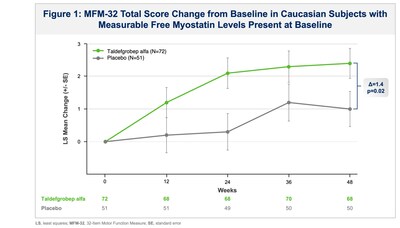Biohaven Provides Update on Taldefgrobep Alfa Development Program for Spinal Muscular Atrophy and Obesity
Biohaven Provides Update on Taldefgrobep Alfa Development Program for Spinal Muscular Atrophy and Obesity |
| [25-November-2024] |
NEW HAVEN, Conn., Nov. 25, 2024 /PRNewswire/ -- Biohaven Ltd. (NYSE: BHVN) (Biohaven), a global clinical-stage biopharmaceutical company focused on the discovery, development and commercialization of life-changing therapies to treat a broad range of rare and common diseases, provided an update today regarding the taldefgrobep alfa development programs in SMA and obesity. In the RESILIENT SMA study, taldefgrobep showed clinically meaningful improvements in motor function at all timepoints on the Motor Function Measurement-32 scale (MFM-32) but the treatment arm did not statistically separate on the primary outcome at 48 weeks compared to the placebo+standard of care (SOC) group. Signals of efficacy were observed in clinically relevant and biomarker-defined subgroups including those related to age, ambulatory status, background therapy, and presence of myostatin at baseline. Notably, there was an unexpectedly large subgroup (35%) of subjects without measurable levels of myostatin at baseline and imbalances in some genetic factors (SMN2 copy number, race) across treatment arms. Diverse populations are affected by SMA, but its genetic epidemiology and carrier rates vary with race or ethnicity, with more than a 2-fold higher prevalence in Caucasian compared to non-Caucasian populations1. Analyses of prespecified subgroups by race and ethnicity demonstrated that the largest study population (87% Caucasian; n=180) showed a 2.2-point change-from-baseline improvement with taldefgrobep treatment on the MFM-32 at Week 48 compared to a 1.1-point change-from-baseline improvement in the corresponding placebo+SOC group (p < 0.039). The improvement associated with taldefgrobep in this subgroup was further increased to a 1.4-point placebo adjusted change-from-baseline (p=0.02) when analyzed by subjects who had measurable myostatin levels at baseline (see Figure 1). These benefits on the MFM-32 continued to increase in the open-label extension period based on preliminary data through Extension Week 24. Moreover, a responder analysis of this myostatin-positive subgroup, with response defined as ≥ 3-point change from baseline improvement on the MFM-32 at Week 48, showed that 50% of taldefgrobep-treated subjects responded compared to 30% in the placebo+SOC arm. Non-Caucasian subjects (n=26) had a higher than expected placebo response and did not separate from placebo on the MFM-32 at Week 48 (p=0.24). Significant enrichment of known, common genetic polymorphisms in non-Caucasian subjects, considered likely to confer myostatin-inhibitory independence for myostatin therapies, are probable in explaining this ethnic separation of responsiveness to therapy. This provides a potentially facile biomarker for identifying SMA patients likely to benefit from taldefgrobep and other myostatin therapies. Further analysis is ongoing to better understand the likely potential impact of these readily monitorable biomarker and genetic factors, including myostatin allele frequencies, in both the potential lower overall response in treated subjects and the overall higher response observed in placebo subjects. In the overall study population, and relevant to activity of taldefgrobep on muscle and fat, prespecified outcome measures analyzing the change from baseline in body composition at Week 48 demonstrated a greater reduction in the percent change in total body fat mass in the taldefgrobep arm compared to the placebo+SOC arm (p=0.008) as measured by dual energy x-ray absorptiometry (DXA). The taldefgrobep arm also showed numerically larger increases in lean muscle mass and bone density compared to the placebo+SOC arm. Importantly, variables such as race or baseline myostatin levels did not alter the impact of taldefgrobep on the favorable effects on fat mass over the course of the study. These results suggest that the body composition changes observed in subjects treated with taldefgrobep, including lower fat mass, are not solely mediated by taldefgrobep's effects on myostatin but also through its effects on other targets such as activin A. The favorable effects observed on overall body composition (fat and lean mass) is consistent with nonclinical data showing that taldefgrobep has direct effects on adipose tissue mediated by activin receptor signaling through multiple ligands, including activin A, myostatin and others. Notably, taldefgrobep is the first and only myostatin blocking agent that has shown the ability to favorably change fat mass in people with SMA. This finding has important implications for the potential of taldefgrobep as a treatment for obesity in a broad population. Based upon data from this study demonstrating target engagement (i.e., myostatin reduction) and taldefgrobep-associated changes in body composition (i.e., fat mass, lean muscle mass and bone density), Biohaven intends to accelerate taldefgrobep clinical plans in 4Q24, advancing a user-friendly, self-administered autoinjector in adults living with overweight and obesity, medical conditions defined by excess, abnormal body fat. Biomarker analyses demonstrated that taldefgrobep achieved robust target engagement, reducing myostatin levels in all treated subjects below the level of detection at all time points measured through Week 48. Post hoc efficacy analyses in subjects with measurable baseline myostatin (the pharmacological target of taldefgrobep) showed an improved efficacy signal in this myostatin-positive population. Cliff Bechtold, Taldefgrobep Development Lead and President of Biohaven Ireland, commented, "SMA is a devastating rare disease and although we are disappointed that taldefgrobep did not achieve a statistically significant difference in the broad study population on the MFM-32, we are encouraged that a majority subgroup did show a treatment benefit compared to the placebo arm. The observed treatment effect on motor function, which had a similar magnitude on the MFM-32 after 1 year of treatment as approved therapies (i.e., risdiplam), along with the strong biomarker evidence of target engagement, suggests that taldefgrobep may play a potentially beneficial role in a majority subgroup population of SMA patients. Additionally, taldefgrobep demonstrated an important beneficial effect on body composition which supports our plans to accelerate development in broader populations with obesity." Taldefgrobep was well-tolerated in the RESILIENT trial with 97% of subjects continuing into the optional long-term extension, which will remain open and ongoing pending discussion with FDA. There were no taldefgrobep treatment-related SAEs. Evaluation of additional RESILIENT clinical and biomarker data is ongoing, and Biohaven plans to engage with FDA regarding these emerging data to discuss a path forward. Full topline data will be presented at an upcoming scientific meeting. Lindsey Lair, MD, MBA, Vice President of Neurology and Clinical Lead for SMA at Biohaven added, "Biohaven remains committed to fighting rare diseases and will engage SMA experts and regulatory authorities regarding the full dataset from the RESILIENT study. We are extremely grateful to the international SMA community - especially the participants and their families, investigators and their teams, and patient advocacy groups who made the trial possible." About Taldefgrobep alfa About SMA About Biohaven Forward-looking Statements (1: https://www.ncbi.nlm.nih.gov/books/NBK1352/) Investor Contact: Media Contact:
SOURCE Biohaven Ltd. | ||
Company Codes: NYSE:BHVN |





















